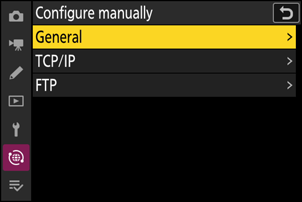FTP Servers: Connecting via Ethernet
A USB (Type C) to Ethernet adapter (available separately from third-party sources) is required for Ethernet connections. Be sure to connect the adapter to the camera’s USB data connector.
The following USB-to-Ethernet adapters have been tested and approved for use:
- Anker A83130A1 PowerExpand USB‑C to Gigabit Ethernet adapters
- Anker A83130A2 PowerExpand USB‑C to Gigabit Ethernet adapters
- Note that USB-to-Ethernet adapters will not function when connected to the camera’s USB Power Delivery connector.
Connecting to Multiple Devices
The camera can connect to only one type of device (computer, FTP server, or smart device) at a time. End the current connection before attempting to connect to a device of a different type.
For information on wireless- or Ethernet-related errors, see “Troubleshooting Wireless LAN and Ethernet Connections” (0Troubleshooting Wireless LAN and Ethernet Connections).
Connecting to FTP Servers via Ethernet
Connect to FTP servers via a third-party USB (Type C) to Ethernet adapter connected to the camera’s USB data connector.
- Servers can be configured using standard FTP services—including IIS (Internet Information Services)—available with Windows 11 and Windows 10.
- Internet FTP connections and connection to FTP servers running third-party software are not supported.
- Before connecting to a server via FTPS, you will need to load a root certificate onto the camera. This can be done using [Connect to FTP server] > [Options] > [Manage root certificate] > [Import root certificate] in the network menu.
- Contact the network administrator for the FTPS server in question for information on acquiring root certificates.
Attach a third-party USB-to-Ethernet adapter to the camera’s USB data connector and then connect to the FTP server using an Ethernet cable.
- Connect the Ethernet cable to the USB-to-Ethernet adapter. Do not use force or attempt to insert the connectors at an angle.
- Connect the other end of the cable to an FTP server or router.
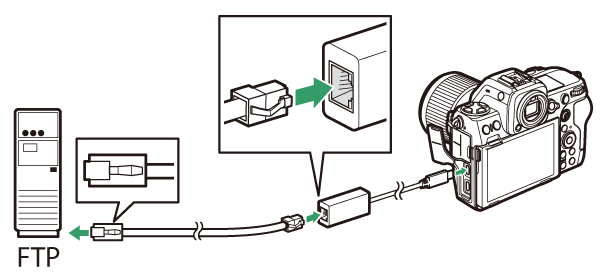
Select [USB-LAN] for [USB data connection] in the network menu.
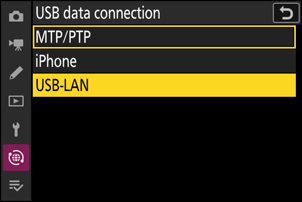
Select [Connect to FTP server] in the network menu, then highlight [Network settings] and press 2.
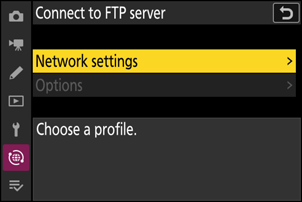
Highlight [Create profile] and press J.
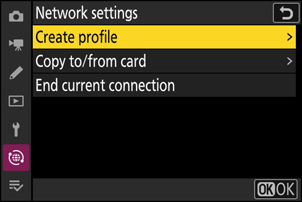
Highlight [Connection wizard] and press 2.
The connection wizard will launch.
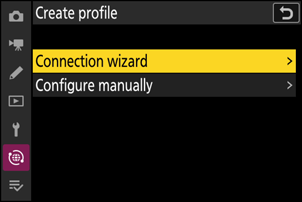
Name the new profile.
- To proceed to the next step without changing the default name, press X.
- Whatever name you choose will appear in the network menu [Connect to FTP server] > [Network settings] list.
- To rename the profile, press J. For information on text entry, see “Text Entry” (0Text Entry). Press X to proceed after entering a name.
- There may be a delay before the camera detects the USB-to-Ethernet adapter. If the camera is unable to detect an Ethernet connection, the wizard will be configured to begin creation of a wireless LAN profile with the default name “WLAN1”. Tap Z or press 4 to return to Step 4, wait about 10 seconds, and then try again.
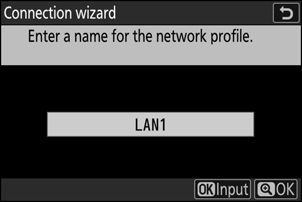
Obtain or select an IP address.
Highlight one of the following options and press J.

Option Description [Obtain automatically] Select this option if the network is configured to supply the IP address automatically. A “configuration complete” message will be displayed once an IP address has been assigned. [Enter manually] Enter the IP address and sub-net mask manually.
- Press J; you will be prompted to enter the IP address.
- Rotate the main command dial to highlight segments.
- Press 4 or 2 to change the highlighted segment and press J to save changes.
- Next, press X; a “configuration complete” message will be displayed. Press X again to display the sub-net mask.
- Press 1 or 3 to edit the sub-net mask and press J; a “configuration complete” message will be displayed.
Press J to proceed when the “configuration complete” message is displayed.
Choose the server type.
Highlight [FTP], [SFTP] (SSH FTP), or [FTPS] (FTP-SSL) and press J to display a dialog where you can enter the server address.
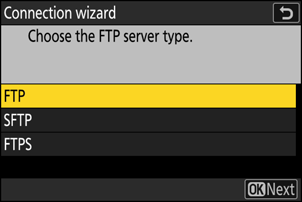
Enter the server address.
Press J to enter the server URL or IP address.
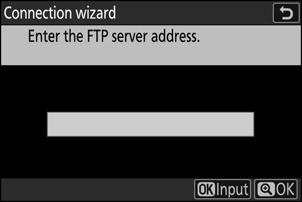
Press X when entry is complete.
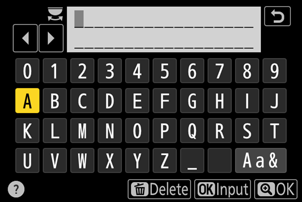
Press X again to connect to the FTP server. You will be prompted to choose a login method.
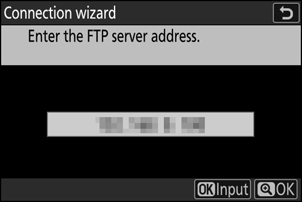
Log in.
Highlight one of the following options and press J.
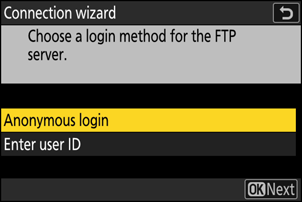
Option Description [Anonymous login] Select this option if the server does not require a user ID or password. This option can only be used with servers that are configured for anonymous login. If login is successful, the camera will prompt you to choose a destination. [Enter user ID] Enter a user ID and password. Press J to log in when entry is complete. If login is successful, the camera will prompt you to choose a destination. The ports used for FTP vary with the server type. The port numbers are listed below.
- [FTP]: TCP ports 21 and 32768 through 61000
- [SFTP]: TCP ports 22 and 32768 through 61000
- [FTPS]: TCP ports 21 and 32768 through 61000
- File transfer may be blocked if the server firewall is not configured to allow access to the appropriate ports.
Choose a destination folder.
Highlight one of the following options and press J.
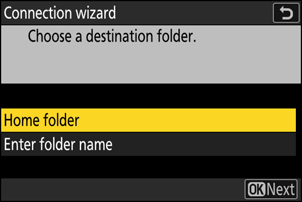
Option Description [Home folder] Select this option to select the server’s home folder as the destination for pictures uploaded from the camera. A “setup complete” dialog will be displayed if the operation is successful. [Enter folder name] Enter the destination folder name manually. The folder must already exist on the server. Enter the folder name and path when prompted and press J to display the “setup complete” dialog. Check the connection.
When a connection is established, the profile name will be displayed in green in the camera [Connect to FTP server] menu.
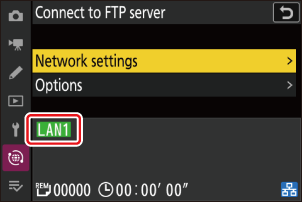
A connection has now been established between the camera and the FTP server.
“FTP” will appear in the camera shooting display once a connection is established. If a connection error occurs, this indicator will be displayed in red together with a C icon.
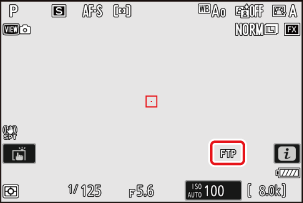
Pictures taken with the camera can be uploaded to the FTP server as described under “Uploading Pictures” (0 Uploading Pictures) in the chapter titled “What You Can Do When the Camera Is Connected to a Computer or FTP Server”.
Ending the Connection to the FTP Server
You can end the connection by:
- turning the camera off, or
- selecting [End current connection] for [Connect to FTP server] > [Network settings] in the network menu.

